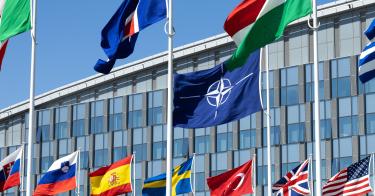NATO’s June summit in The Hague will present a critical opportunity for America’s allies to reaffirm their commitment to collective security. The worsening security environment in both Europe and the Indo-Pacific can only be met by increased burden-sharing from all NATO members.
NATO: An Alliance Ripe for Change
Longstanding imbalances in defense expenditures and strategic responsibilities within the alliance have culminated in a vital need to undertake four reforms.
Reinforce Article 3: Commitment to Self-Defense
Article 3 of the North Atlantic Treaty requires NATO members to “maintain and develop their individual and collective capacity to resist armed attack.” There are legitimate concerns that many nations may not be fully capable of defending themselves, let alone aiding the collective capacity to support one another in conflict.
>>> NATO’s Underspending Problem: America’s Allies Must Embrace Fair Burden Sharing
According to a recent analysis by the Heritage Foundation, America’s NATO allies have collectively underfunded their defense commitments by more than $827 billion. Notable shortfalls include Germany ($249 billion), Italy ($150 billion), and Spain ($150 billion). These shortfalls represent a decade of underinvestment in capabilities and maintenance. The end result is less-capable militaries.
During this period, the U.S. averaged defense spending equivalent to 3.42 percent of GDP, while the average NATO member spent 1.59 percent—less than half as much as the U.S. spent and well below NATO’s 2 percent benchmark first articulated in 2006 and reaffirmed by all members at the 2014 Wales Summit.
Russia’s annexation of Crimea in 2014 and its invasion of Ukraine in 2022 exposed the consequences of decades of underinvestment. European nations have struggled to deliver on promised military support to Ukraine, with depleted stockpiles and limited industrial capacity—especially in munitions—undermining their ability to take the lead on military aid to Ukraine.
The 2 percent minimum has become a political bellwether in Washington, and fulfilling these obligations will strengthen transatlantic relations.
Raise NATO Spending Targets to at Least 3 percent
NATO’s current defense-spending target of 2 percent has proven insufficient to deter aggression. There are now growing calls for a 3 percent threshold—not as a new obligation, but as a necessary correction for more than a decade of underinvestment. In fact, most countries that have a deficit in spending will likely take until 2030 to 2035 just to reach the original 2-percent minimum target agreed upon in 2014.
This higher minimum threshold would accelerate rearmament in munitions production, military mobility infrastructure, and training. It would signal strategic resolve.
Reform the 20 Percent Equipment and R&D Requirement
The 2014 Wales Summit also set a target for NATO members to allocate at least 20 percent of their defense budgets “on major equipment, including related Research & Development.” However, many nations only met this metric by spending below the 2 percent minimum target, undercutting the policy’s intent.
For example, Spain has consistently met the 20 percent equipment requirement, but only spent 1 percent of overall GDP on defense. When looking only at the equipment expenditure target, Spain could claim to have overspent the minimum target by $1.3 billion since 2014. However, when considering that the target is to spend 0.4 percent of GDP on equipment—20 percent of 2 percent of GDP—Spain is down $28.4 billion on equipment since 2014.
>>> Look to the Seas: Why a Regional Focus in the North and South Strengthens NATO Deterrence
Therefore, NATO could explore reforming its guideline by setting a floor on equipment spending that uses GDP as a reference. For example, a new standard could be to spend 0.6 percent of GDP for equipment—20 percent of a revised 3 percent GDP minimum. Given Europe’s travails in delivering military equipment to Ukraine on promised timelines, these conversations are both timely and germane. Further, implementing such a policy is prudent for any individual nation, whether or not it is formally codified in a declaration.
Address the Fiscal Realities of the United States
After decades of overspending, the United States is approaching its fiscal limits. Interest payments on U.S. national debt are set to exceed annual defense spending. Washington cannot afford to subsidize allies while bearing an outsized share of global security burdens. As China adopts an increasingly bellicose posture toward Taiwan, deepens ties with Iran, and provides support for Russia’s actions in Ukraine, NATO must grapple with global instability and embrace genuine burden-sharing . The most significant thing European NATO members can do to help America deter China is to provide the bulk of conventional deterrence in Europe so that U.S. forces can shift to the Indo-Pacific.
NATO must use the Hague summit to recommit to Article 3; adopt a robust 3-percent-of-GDP defense-spending target; consider setting equipment-spending standards to 0.6 percent of GDP; and recognize the fiscal limitations facing the United States.
Failure to act now, individually and collectively, will increase the likelihood of future conflict. Decisive reform, however, will ensure NATO remains a credible force for peace and deterrence well into the 21st century.
This piece originally appeared in 1945




